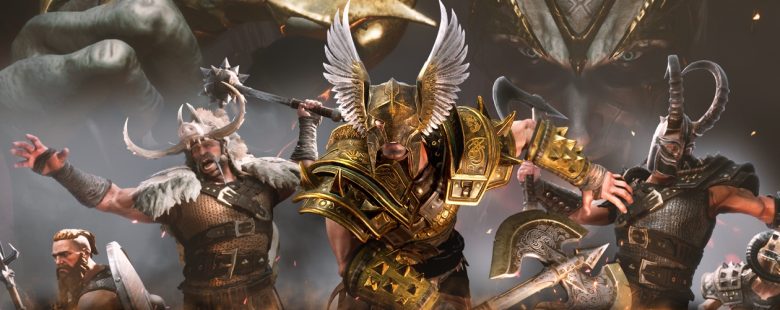The tale of Rune II’s development is a saga in itself – a tale full of betrayal, greed, tyrannous giants (Zenimax), and the heroic acts of a small group of developers trying to avert Ragnarok. The full details are well documented, as can be seen in our earlier coverage, and my upcoming interview with the team at Studio 369, so having managed to make it all the way to release, what condition is the game now in? We didn’t review the original, cursed release on Epic a year ago but I did play Rune II in its frankly shocking pre-Studio 369 form and let me tell you, it was barely a game at all with almost no content and a complete disregard for basic QA. I was therefore in a good position to see how much had changed with this build, and to see whether it lived up to the legacy of the much loved original.
Rune II sees your player-created Viking called forth by the mighty Heimdall to stop Loki’s evil plan to unleash an unending cycle of Ragnarok on Midgard. Setting up your character is pretty standard RPG fare, with a choice of appropriate hairstyles and facial hair to choose from and a refreshingly accessible approach to stats.
Your points from levelling up go towards one of four branches – strength, dexterity, wisdom, or constitution, with each having various logical effects on your overall character abilities. While this may sound limited in comparison to the labyrinthine systems of many RPGs it is perfectly suited to the more action-focused approach of Rune II. Equipment and weapons also have built-in enhancements and there is a lot of loot-based fun to be had in trying to set up the best build for your gaming style.

Graphically, Rune II is a far prettier game than last year’s version. It doesn’t reach the cutting edge standards of Assassin’s Creed: Valhalla, but there is a good amount of detail in the environments and enemy models are nicely designed. The biggest improvement is the much more defined Ages that you progress through. This sees the familiar landscape transformed by the ravages of ice, fire, and darkness, and I really liked the way in which these changes made the world feel changed and suited the story well. The explorable world is large, although I would have liked to see more incentive to leave the beaten path. There are runestones, chests, and enemies to slay scattered across the map but these are largely optional extras.
Last year’s release had no real narrative to speak of, whereas Studio 369 have built a full campaign into the Decapitation Edition. In order to take on Loki and secure the future of Midgard, you’ll have to take on quests, explore dungeons, and fight off Loki’s hordes across the various ages of Ragnarok. In traditional action RPG fashion, many of these quests are relatively simple kill or fetch missions but they do provide a suitable framework for the limb lopping and brutal combat. There is full voice acting for the various villagers you’ll meet but this is of hugely differing quality. Some of the accents are almost impossible to place and I found myself skipping a number of these conversations and using the subtitles instead.

Studio 369 have described Rune II as akin to a mix of Skyrim and Diablo, a combination that gives a good idea of the game. The main focus here is combat and loot – lots of lovely loot. Enemies drop loot, chests contain loot, you pick up ingredients that you can craft into more loot, with the result being an ever-evolving selection of weapons and equipment for your Viking. This is all easy to manage with an intuitive interface and an easily accessed combination of radial equipment menu and skills hotbar. I found myself quickly switching between weapon sets to suit the combat style of my enemies, alternating between huge battle axes and the cagier sword and shield. While not as meaty as the likes of Dark Souls, there is a clear influence to be felt here, even if just for the ubiquitous stamina bar. My build helpfully negated this aspect and I was able to roll around like a Nordic Sonic the Hedgehog.
After the opening tutorial missions and the first dungeon, you’ll be provided with the choice of aligning to a God. Odin, Hel, and Thor all open up different skill trees and playing styles, alongside the choice to go it alone as a Heathen. Odin is the path for healer style support skills and group buffs, Hel is a combination of rogue and necromancer, whilst Thor is all about magic damage. The Heathen path is focused on tank-style survivability and is my recommendation for a first playthrough in single player mode. The other modes are all good fun and offer genuine alternative approaches but are mostly more suited to co-operative play.

The bulk of my experience with Rune II was playing through the single player campaign but I was able to check out the multiplayer aspects too. The whole story can be played through in group co-op and the result is wonderfully chaotic. Enemy mobs scale with the size of the group which leads to massive melee battles with weapons and limbs flying everywhere. Studio 369 have kept Rune I’s ability to throw your weapon at any time, and you can even pick up severed body parts as makeshift weapons too. This isn’t a serious Viking-sim by any means, but it doesn’t feel any less enjoyable because of that.


